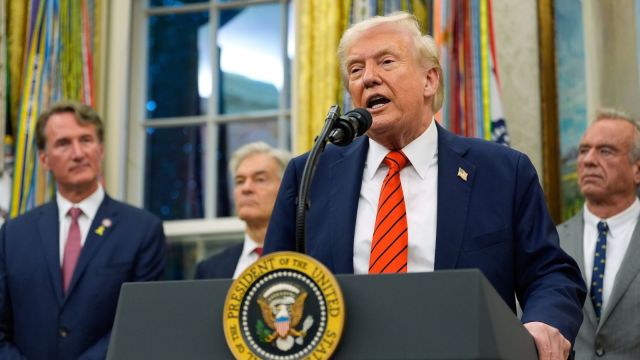When the Trump guardrails fall
Nine months into Trump’s second term, he has done several things he was stopped from doing during his first term.
 President Donald Trump speaks at the White House, Friday, Oct 10, 2025. (AP Photo)
President Donald Trump speaks at the White House, Friday, Oct 10, 2025. (AP Photo) by Michael S. Schmidt
Since Donald Trump first became president in 2017, I have written many articles — and even a book — that focused on the efforts by his aides to contain his impulses and stop him from waging a retribution campaign against his enemies.
Throughout my reporting, I — like many journalists in the midst of an intense and complex story — wondered: Was I accurately capturing the facts? I knew that the people around Trump often justified working in his administration by saying they would serve as guardrails against his most extreme impulses, but how could I know for sure that these checks on his power were actually the force holding him back?
I had those doubts because we, as reporters, very rarely get to see the counterfactual, to test our reporting by witnessing how the world would play out if the circumstances were different.
But Trump’s second term has given us that unique opportunity.
The people who sought to restrain the president back then, like his former chief of staff John Kelly and his White House counsel Don McGahn, are gone, and so are the hypotheticals. We are now seeing how a truly unshackled Trump uses his power.
Nine months into Trump’s second term, he has done several things he was stopped from doing during his first term. He has exerted more direct pressure on the Justice Department to bring charges, apparently spurring prosecutors to secure an indictment against at least one target who eluded him during his first term. And he has greatly expanded presidential powers, including by deploying the military on domestic soil in more sweeping ways than he did during his first term.
Here, I’ll explain what Trump’s second term has taught us about his first: The guardrails worked, up to a point. (See: Jan 6.)
And many of the stark warnings about what would happen without them — which were issued loudly during the presidential campaign by the very people who had once sought to restrain the president — have proved true.
An Eye on the Justice Department
As early as 2017, Trump tried to pressure Attorney General Jeff Sessions to prosecute his rivals, like Hillary Clinton. But Sessions and top administration aides managed to distract Trump for months. Sessions held onto his job for nearly two years, and no charges were brought against Clinton.
At the time, Trump himself was under investigation by special counsel Robert Mueller for obstructing the FBI’s inquiry into his campaign’s ties to Russia. Trump complained endlessly about why his own Justice Department was investigating him, casting a cloud over his presidency, without looking into his perceived enemies.
As the pressure built on Trump, he became more fixated on the idea of not only prosecuting his rivals, including former FBI Director James Comey, but siccing the IRS on them.
Repeatedly, Kelly and McGahn managed to stop Trump. They refused to order the Justice Department to investigate his rivals, telling him that what he wanted to do was potentially illegal. McGahn even wrote Trump an extraordinary memo in which he warned him that he could be defeated at the ballot box — or impeached — if he tried to meddle in prosecutions.
The Justice Department’s prosecutorial decisions remained insulated from the president. While many of his perceived enemies came under investigation, none were ever charged. This left Trump angry, convinced that his aides and political appointees had wrongly constrained him.
The Warnings Begin
In the four years Trump was out of office, he was indicted four times. At the same time, his aides, including Stephen Miller, an adviser during his first term who is now his deputy chief of staff — considered the lessons they learned during his first term and figured out how Trump could harness the powers of the presidency more effectively for his own political ends.
Trump’s allies pledged that if he ever returned to the White House, he would not have guardrails like Kelly around to try to stop him.
During the 2024 campaign, Kelly, other top generals who worked for Trump and other former aides issued a series of stark warnings. They said that not only would Trump follow through on prosecuting his rivals but he would use the military domestically on Americans. And, they said, Trump would use his power in audacious and potentially illegal ways to achieve his political goals and erode the independence of bedrock institutions of American democracy.
Trump’s opponent, Kamala Harris, echoed those warnings on the campaign trail.
Republicans pooh-poohed the warnings, saying that the former officials were just castoffs suffering from Trump Derangement Syndrome.
An Expansion of Power
Since returning to office, Trump has largely done exactly what Kelly and the former aides warned he would. He has engaged in an aggressive retribution campaign. He has pierced the Justice Department’s prosecutorial decision-making process by publicly and privately telling Attorney General Pam Bondi — including in a message apparently accidentally posted on Truth Social — whom to charge, including Comey.
Bondi’s department charged Comey five days later, shortly after pushing out a prosecutor who had raised concerns about a potential case against Comey. An indictment against New York Attorney General Letitia James, a Democrat who sued Trump for fraud, followed soon after.
Trump has deployed the National Guard and Immigration and Customs Enforcement agents to several American cities run by Democratic mayors over their objections. He has dismantled large parts of the federal bureaucracy and workforce, challenging Congress’ control over spending. And his administration’s responses to some high-profile court rulings related to immigration issues have raised questions about whether they are following judges’ orders.
For this piece, I reached out to Kelly to see if he would talk about how his warnings lined up with the way Trump has governed. But Kelly declined to comment. Since Trump won, he has said little publicly, believing he already warned the country and there is nothing left for him to say.
This article originally appeared in The New York Times.





